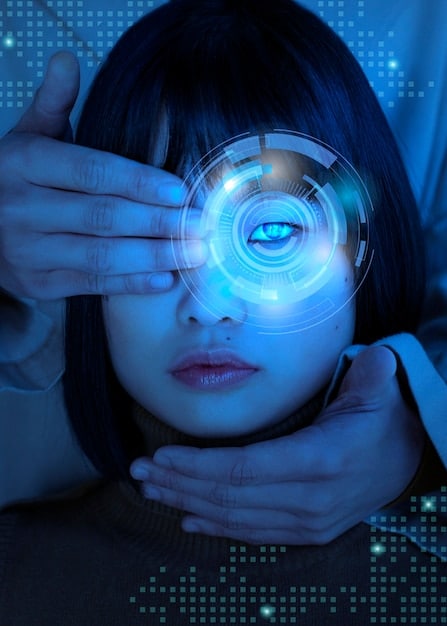Biometric Authentication: Your Body as Your Password in the US

The rise of biometric authentication in the US signifies a pivotal shift in security, transforming unique physiological and behavioral traits into robust, personalized digital keys against cyber threats.
In an increasingly digital world, the quest for robust and convenient security solutions is paramount. As traditional passwords prove vulnerable and cumbersome, a new frontier in authentication is rapidly gaining ground across the United States: The Rise of Biometric Authentication: How Your Body Is Becoming Your Password in the US. This transformative shift leverages our inherent biological and behavioral characteristics, turning them into unique digital ‘keys’ that promise enhanced security and unprecedented ease of access.
The Fundamentals of Biometric Authentication
Biometric authentication refers to security processes that verify an individual’s identity by measuring and analyzing unique physical or behavioral characteristics. Unlike passwords, which can be forgotten, stolen, or guessed, biometrics are inherently tied to the individual, offering a higher degree of assurance. For instance, your fingerprint pattern or your distinctive walking gait are intrinsically yours.
The core principle behind biometrics involves capturing a unique trait, converting it into a digital template, and storing it for future comparisons. When you attempt to access a system, your biometric data is captured again, compared against the stored template, and, if a match is found, access is granted. This process is designed to be swift and seamless, blending security with user convenience.
Types of Biometric Modalities
Biometric systems can broadly be categorized into two main groups: physical and behavioral. Each offers distinct advantages and applications, contributing to a multifaceted security landscape.
- Physiological Biometrics: These are based on innate physical characteristics, which are generally stable over time. Examples include fingerprints, facial recognition, iris scans, and retina scans.
- Behavioral Biometrics: These methods analyze unique patterns in an individual’s behavior, which can be more dynamic. Voice recognition, gait analysis, and signature verification fall into this category.
The selection of a specific biometric modality often depends on the required level of security, the environment of use, and user acceptance. For example, fingerprint scanners are ubiquitous in smartphones due to their balance of security and convenience, while iris scans are often reserved for higher-security environments.
The accuracy of these systems is continuously improving, driven by advancements in sensor technology and machine learning algorithms. False acceptance rates (FAR) and false rejection rates (FRR) are critical metrics that define the reliability of a biometric system, and developers are constantly working to minimize these errors for diverse user populations.
Driving Factors Behind Biometric Adoption in the US
Several compelling factors are accelerating the embrace of biometric authentication across various sectors in the United States. From escalating cyber threats to the demand for seamless user experiences, the landscape is ripe for this technological shift.
One of the primary drivers is the persistent vulnerability of traditional password-based security. Data breaches rooted in weak, reused, or stolen passwords are a pervasive and costly problem for businesses and individuals alike. Biometrics offer a more robust defense, as stealing a fingerprint or an iris pattern is significantly more challenging than hacking an alphanumeric string.
Enhanced Security Posture
Biometric data is inherently unique to each individual, making it exceptionally difficult for unauthorized users to replicate. This intrinsic uniqueness means that even if a biometric template is compromised, it cannot be easily used to impersonate the individual without severe technological hurdles. The challenge of forging living, dynamic biometric data provides a strong deterrent against sophisticated attacks. For example, liveness detection technologies prevent the use of static images or molds.
- Reduced Fraud: Biometrics can significantly lower instances of identity theft and unauthorized access.
- Stronger Authenticity: Verifies the individual’s presence, rather than just knowledge of a password.
- Multi-Factor Authentication (MFA): Often combined with other factors (like a PIN or token) for even greater security, creating a layered defense.
The integration of biometrics into multi-factor authentication (MFA) strategies further elevates security. By combining “something you are” (biometric) with “something you know” (PIN) or “something you have” (device), organizations can create highly resilient security protocols that are difficult to bypass.

User Convenience and Efficiency
Beyond security, the frictionless user experience offered by biometrics is a major appeal. No more memorizing complex passwords, resetting forgotten ones, or typing lengthy character strings. A quick glance at a camera, a touch of a finger, or a voice command can grant access instantaneously.
This convenience translates into significant time savings and reduced frustration for users, leading to higher adoption rates for secure applications. For businesses, streamlined authentication processes can improve operational efficiency and customer satisfaction, as employees and customers spend less time on login procedures.
The speed with which biometric authentication operates is transforming sectors that require rapid verification, such as retail payments and airport security. The ability to verify identity in seconds reduces queues and enhances the overall flow of operations, proving beneficial for both the service provider and the end-user.
Applications Across US Industries
The deployment of biometric authentication is not confined to a single sector but is rapidly expanding across a diverse range of industries in the United States, revolutionizing how identity is verified and access is granted.
In the consumer electronics market, fingerprint scanners and facial recognition on smartphones have become standard features, making daily interactions like unlocking devices and authorizing mobile payments effortless. This widespread adoption has familiarized the average American with biometric technology, paving the way for its acceptance in other areas.
Finance and Banking
The financial sector, a prime target for cybercrime, has been an early adopter of biometrics. Banks are implementing fingerprint, facial, and voice recognition for mobile banking apps, online transactions, and ATM withdrawals. This added layer of security helps protect customer accounts from fraud, while simultaneously improving the banking experience by eliminating the need for complex passwords and PINs.
- Secure Transactions: Biometrics enable quick and secure authorization for payments and transfers.
- Customer Onboarding: Streamlines the process of verifying new customers, reducing identity fraud.
- ATM Access: Some banks are exploring biometric-enabled ATMs for cardless withdrawals.
The move towards biometric-enabled payment systems, such as those integrated into point-of-sale terminals, also promises to enhance the security of retail transactions. Customers can authenticate purchases with a simple touch or glance, potentially reducing incidents of credit card fraud and chargebacks for merchants.
Healthcare and Government
In healthcare, biometrics are being used to identify patients accurately, ensuring that the right patient receives the right treatment and that access to sensitive medical records is strictly controlled. This is crucial for maintaining patient privacy and preventing medical errors and fraud.
Government agencies are leveraging biometrics for national security and public services. Border control uses facial and fingerprint recognition to streamline entry processes and identify potential threats. Law enforcement utilizes biometrics for forensic investigations and identification, while departments like the Department of Defense employ them for secure facility access and troop identification.
Travel and Beyond
The travel industry is increasingly integrating biometrics to enhance efficiency and security at airports, from check-in to boarding. Facial recognition boarding gates are becoming more common in major US airports, allowing passengers to move seamlessly through the boarding process without presenting physical documents. This not only improves the traveler experience but also enhances security by verifying the identity of each passenger efficiently.
Beyond these major sectors, biometrics are finding niches in areas such as vehicle access, smart home systems, and even employee time tracking. The versatility and evolving accuracy of these systems suggest that their presence will only continue to grow, making your body an increasingly integrated part of your daily digital interactions.
Challenges and Concerns of Biometric Integration
Despite the undeniable advantages and growing adoption, the widespread integration of biometric authentication in the US is not without its challenges and legitimate concerns. Addressing these issues is crucial for building trust and ensuring the responsible deployment of this powerful technology.
One of the foremost concerns revolves around privacy. Unlike passwords, which can be changed if compromised, biometric data is immutable. If a database containing biometric templates were breached, the implications could be severe and long-lasting, as individuals cannot simply “change their fingerprint” like they would a password. This raises questions about how biometric data is stored, encrypted, and protected from malicious actors.
Privacy and Data Security Risks
The storage and management of biometric templates are critical. While systems often store numerical representations (hashes) rather than raw biometric images, the potential for reverse engineering or database breaches remains a concern. Robust encryption, secure server environments, and strict access controls are paramount to mitigating these risks. Furthermore, the concept of “liveness detection” is vital to prevent spoofing attempts where an attacker might use a replica of a biometric trait.
- Irreversibility of Compromise: Biometric data cannot be “reset” if stolen, leading to lifelong vulnerability.
- Centralized Data Stores: Large databases of biometric templates present attractive targets for cyberattacks.
- Scope Creep: Concerns about how collected biometric data might be used beyond its stated purpose.
The transparency regarding data collection, storage, and usage policies is essential for fostering public confidence. Users need to understand who has access to their biometric data, how it is protected, and whether it could be shared with third parties. Clear communication and robust regulatory frameworks are necessary to navigate these complex privacy landscapes.
Accuracy and Bias Issues
While biometric systems are highly accurate, they are not infallible. False positive and false negative rates, though low, can cause inconvenience or security loopholes. More significantly, concerns around algorithmic bias have emerged, particularly in facial recognition technologies. Studies have shown that some systems may perform less accurately on individuals of certain ethnicities, genders, or age groups, leading to disparities in access and potential discrimination.
Ensuring fairness and accuracy across diverse populations is a critical challenge. Developers are actively working to train AI models on more representative data sets and to implement rigorous testing to identify and mitigate biases. Public trust hinges on the assurance that these technologies are equitable and reliable for everyone.

The Regulatory Landscape and Future Outlook
As biometric authentication becomes more pervasive, the need for clear regulatory frameworks and ethical guidelines in the United States becomes increasingly urgent. Lawmakers and industry bodies are grappling with how to balance innovation and security with individual rights and privacy.
Currently, the US does not have a single, overarching federal law specifically governing biometric data, unlike some other regions. Instead, a patchwork of state-level laws, industry-specific regulations (like HIPAA for healthcare), and general privacy laws apply. States like Illinois (with its Biometric Information Privacy Act – BIPA) have enacted strong protections, creating a complex legal environment for businesses operating nationwide.
Evolving Legal and Ethical Considerations
The debate around biometric regulation largely centers on informed consent, data retention policies, and the right to erasure. Companies are increasingly expected to provide clear disclosures about their biometric data practices and obtain explicit consent from users before collecting their unique physical traits. The evolving legal landscape necessitates continuous adaptation and compliance from organizations leveraging biometric technologies.
Ethical considerations extend beyond privacy to encompass potential misuse, surveillance, and the implications for civil liberties. Public discourse continues on issues such as the use of facial recognition by law enforcement or in public spaces, prompting questions about the balance between security and individual freedom. Transparent governance and public oversight are crucial for building trust.
The Future of Biometric Authentication in the US
Looking ahead, the trajectory of biometric authentication in the US is one of continued growth and refinement. Expect to see greater integration of multimodal biometrics, combining two or more traits (e.g., face and voice) for enhanced security and accuracy. Behavioral biometrics will likely gain prominence, as continuous authentication—where identity is verified throughout a session rather than just at login—becomes more sophisticated.
Innovation in “passive biometrics” will also be key, where authentication occurs without explicit user action, such as through keystroke dynamics or subtle gait analysis. This promises an even more frictionless user experience. Researchers are also exploring novel biometric modalities, from ear shape recognition to vein patterns, expanding the arsenal of unique identifiers.
Ultimately, the future of biometric authentication in the US will be shaped by a delicate interplay of technological advancement, regulatory evolution, public acceptance, and the ongoing need for secure, convenient digital interactions. As our bodies increasingly become our passwords, ensuring the integrity and ethical use of this technology will be paramount for a secure digital society.
| Key Point | Brief Description |
|---|---|
| 🔒 Enhanced Security | Biometrics offer stronger protection than passwords, leveraging unique personal traits for verification. |
| ⚡ User Convenience | Quick, frictionless access without the need to remember complex passwords or PINs. |
| 💡 Broad Applications | Used across finance, healthcare, government, and travel for various verification needs. |
| ⚖️ Privacy Concerns | Irreversible nature of biometric data raises significant privacy and data security issues. |
Frequently Asked Questions About Biometric Authentication
Biometric authentication is a security process that verifies an individual’s identity by measuring and analyzing unique physical (like fingerprints or faces) or behavioral (like voice patterns or gait) characteristics. It converts these traits into digital templates for comparison, granting access if a match is found. This method provides a highly secure and convenient alternative to traditional passwords.
The core difference lies in the “what you are” versus “what you know.” Passwords rely on knowledge that can be forgotten, stolen, or shared. Biometrics, however, use inherent physical or behavioral traits unique to an individual, which are much harder to steal, forge, or replicate. This makes them inherently more secure and offers a frictionless user experience.
The main types fall into two categories: physiological and behavioral. Physiological biometrics include fingerprints, facial recognition, iris scans, and retina scans. Behavioral biometrics encompass voice recognition, gait analysis, and signature verification. Each type has specific applications and varying levels of accuracy and security, often chosen based on the context of use.
The key benefits include enhanced security due to the uniqueness and difficulty of forging biometric data, leading to reduced fraud. It also offers unparalleled convenience, eliminating the need to remember passwords and speeding up authentication processes. Biometrics can often be combined with other factors for robust multi-factor authentication systems, further bolstering defenses.
A primary concern is the irreversibility of compromise; unlike passwords, you cannot change your biometric data if it’s stolen. This raises significant privacy risks regarding data storage, potential breaches, and the possibility of misuse. Ethical considerations also arise concerning surveillance and potential algorithmic biases that might affect certain demographic groups, necessitating strong regulatory oversight.
Conclusion
The journey towards a future where our bodies serve as our primary authentication mechanism in the United States is well underway. The Rise of Biometric Authentication: How Your Body Is Becoming Your Password in the US represents a profound paradigm shift driven by the twin demands of robust security and unparalleled convenience. While challenges related to privacy, data security, and algorithmic bias persist, ongoing innovation and the development of comprehensive regulatory frameworks are paving the way for a more secure and seamless digital experience. As this technology matures, its ethical and equitable deployment will be crucial to harnessing its full potential and ensuring a trusted environment where our unique biological traits serve as reliable keys to our increasingly interconnected lives.





